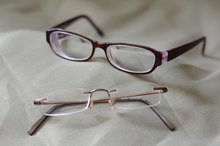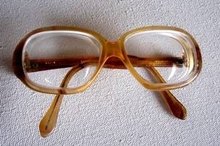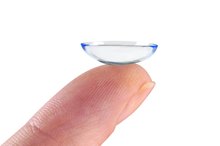The Best Non-Scratch or Scratch-Resistant Eyeglass Lenses
Eyeglass lenses tend to scratch with use or neglect. A scratched up pair of eyeglasses can compromise vision and be a source of annoyance. Technology has yet to come out with scratch-free, lenses but most lenses can be treated with scratch-resistant coating to prolong the life of the eyeglasses. Scratch-resistance involves coating the lenses, both front and back, with a clear, hard coating to withstand scratches. A number of lenses work well with scratch-resistant coating to offer both comfort and protection against wear and tear.
CR-39 Plastic
While glass lenses tend to scratch less, plastic lenses made with CR-39 plastic make better choices when it comes to scratch resistance. CR-39 plastic is named according to the resin formulation used by the original manufacturer. Not only does CR-39 plastic weigh less than glass, it also offers better ultra-violet protection from the sun, shatters less easily and can be tinted or coated easily. When they are treated with scratch-resistant coating, CR-39 plastic lenses make great choices, as they weigh less than half the weight of glass lenses.
- While glass lenses tend to scratch less, plastic lenses made with CR-39 plastic make better choices when it comes to scratch resistance.
- When they are treated with scratch-resistant coating, CR-39 plastic lenses make great choices, as they weigh less than half the weight of glass lenses.
High Index Plastic Lenses
Problems With High Density Eyeglass Lenses
Learn More
A number of plastic lens materials are thinner and lighter than CR-39 plastic, which offers even more comfort than the standard CR-30 plastic lenses. The higher the refractive index (how effectively the lens bend the light), the lighter the lenses. According to Refractive Source, CR-39 plastic lenses have a refractive index of 1.498, while any high index lenses have a reflective index of 1.523 or higher 1. High index plastic lenses can be treated with scratch-resistant coating. Most high index scratch-resistant lenses are 50 percent lighter than CR-39 plastic lenses. An eye professional can advise on what type of high index lens material is best for your prescription and budget.
- A number of plastic lens materials are thinner and lighter than CR-39 plastic, which offers even more comfort than the standard CR-30 plastic lenses.
Polycarbonated Lenses
Polycarbonated lenses are also popular choices. Made from polycarbonate, a lightweight plastic that can withstand rough handling, polycarbonated lenses are also impact-resistant. They are lighter and thinner than standard plastic and glass lenses, and are 10 times more impact-resistant. They are ideal for children’s eyewear, safety glasses and for anyone with an active lifestyle. Some come with scratch-resistance already built-in, but you can always ask for scratch-resistant coating at the optometrist’s office.
- Polycarbonated lenses are also popular choices.
- Made from polycarbonate, a lightweight plastic that can withstand rough handling, polycarbonated lenses are also impact-resistant.
Professional Advice
How to Find Out My Glasses Prescription
Learn More
Buying a pair of eyeglass with scratch-resistant lenses does not guarantee against scratches. Eye professionals advise using care when handling your eyeglasses. Always keep them in a cushioned case when not in use. Wash lenses with warm soapy water and dry or clean them with a soft microfiber cloth.
- Buying a pair of eyeglass with scratch-resistant lenses does not guarantee against scratches.
- Eye professionals advise using care when handling your eyeglasses.
Related Articles
References
Writer Bio
Based in San Diego, Calif., Angeline Oppenheimer has been writing health-related articles since 2007. Her articles have appeared in "San Diego Family" magazine and on various websites. She holds a degree in literature and writing studies from California State University, San Marcos.







